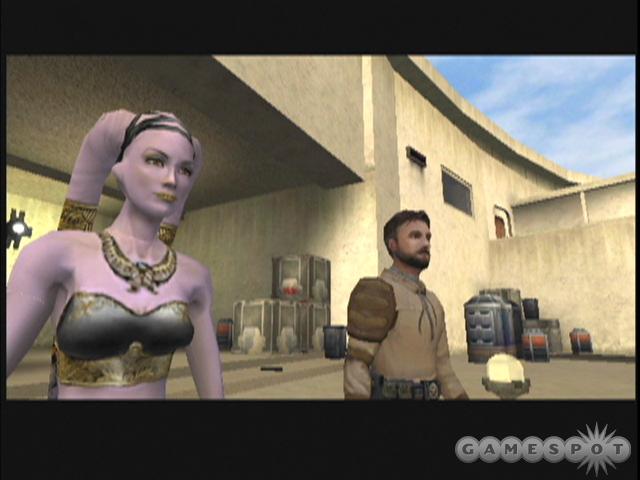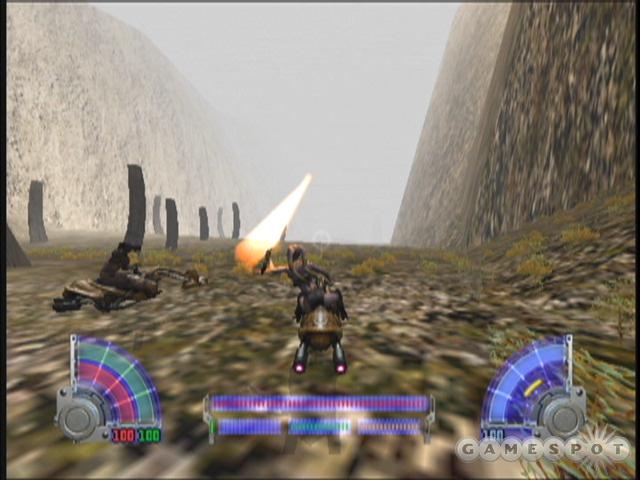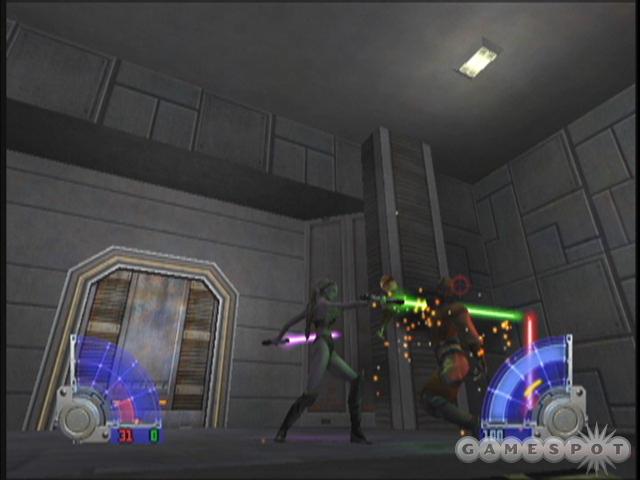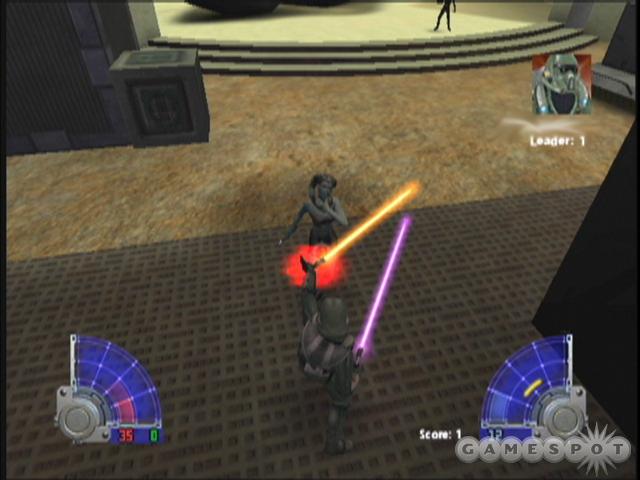There are dozens of Star Wars games on the market, but none captures the excitement of lightsaber combat as well as the Jedi Knight games. Jedi Knight: Jedi Academy is the third game in the series, or, technically, the fourth if you count 1995's Dark Forces, which didn't bear the Jedi Knight name (and didn't let you use lightsabers or Force powers, either). It is also the second Jedi Knight game to appear on the Xbox. Jedi Academy is not a revolutionary product, as it uses the same Quake III engine and gameplay elements as last year's well-received Jedi Knight II: Jedi Outcast. It manages to take all the fun parts from its predecessor and greatly expands on them to create an engaging, new action game in its own right.

You play as Jaden, the new protagonist in Jedi Academy. You previously played as Kyle Katarn, a strong yet reluctant Jedi, in the previous Jedi Knight games. Kyle has since joined Luke Skywalker as a teacher at the Jedi Academy and is looking for new students. You can actually customize Jaden's character. You can be male or female, you can choose from one of several different races, and you can wear different outfits. In any event, you also happen to be the most promising student in the new class. Apparently, you've even built your own lightsaber, which is highly abnormal since lightsabers are usually built during training.
If Jaden is considered an unusual student, then your training is anything but common. Jaden's transport ship is attacked when it arrives at the Academy and then crashes into the ground. You and another student, Rosh, are the only survivors. He becomes your friend, yet seems to become jealous of your abilities and is upset by his own slow progress. You don't have time to worry about Rosh, though. The storyline revolves around solving several questions related to your attack at the start of the game. Why did a female twi'lek steal information from Luke's chambers when the students were away rescuing the downed ship? What role does the Imperial remnant fill in this attack, and is it related to the mysterious Cult of Ragnos that is appearing in the galaxy? After a short training mission, you immediately set out to help Luke and Kyle obtain answers to these questions. The game's story doesn't get in the way of the action but serves to tie the numerous missions together.
Jaden travels all over the galaxy in the game. The missions are surprisingly varied, and that is one of the most pleasant aspects of the game. One mission has you fighting stormtroopers on a refinery, while another mission has you stranded on a desert planet until you can find pieces to repair your ship. Like its predecessor, Jedi Academy takes you to familiar locations, like Tatooine and Coruscant. Some missions can last over an hour while others take five minutes, so you never quite know what to expect. Jedi Academy has an overall linear path, but you can mix this up to a certain degree. You start out with a set of five missions to choose from. Once you complete four missions, you can either return to the academy to gain new skills and advance the story, or you can play the fifth mission. Completing the fifth mission will grant you an extra point to distribute to your Force powers, but you may find yourself doing so just because the missions are diverse and entertaining. After returning to the academy and completing a plot-critical mission, you are offered a new set of five missions. This repeats three times until you complete the game, adding up to about 10 to 15 hours' worth of solid single-player action, depending on what missions you choose and what skills you use.

Jedi Academy does an excellent job of balancing its missions. Your first set of missions puts you on reconnaissance or rescue duties where you'll face mercenaries, poorly equipped stormtroopers, and the occasional dark Jedi. This is by no means boring. Let's face it: It's very satisfying to completely dominate your enemies by hacking through them with your lightsaber as they desperately try to shoot you down. By the last set of missions, you'll constantly be fighting dark Jedi and stormtroopers in power armor. The game justifies this by explaining that new students take easier missions and then progress to more challenging ones as their training continues. You also drive a variety of vehicles throughout your journey. You get to take speeders out for spins, and you get to control an AT-ST while attempting to ravage Imperial remnant bases from within. While not a crucial part of the game, vehicles are a welcome addition to the normal gameplay.
Perhaps the best improvement in Jedi Academy over Jedi Knight II is that it grants you your lightsaber and Force powers at the very start of the game. You spent the first portion of Jedi Outcast without your abilities, and it made those sections rather tedious by contrast. The weapons were interesting enough, but people play these games for the Jedi combat. So this time around, the developer's decision to focus the gameplay on these Jedi abilities is a major boost for the game. That's not to say that conventional weapons are useless. While it's possible to finish the game without ever putting down your lightsaber, sometimes rocket launchers, sniper rifles, and grenades can help dispatch of some pesky foes.
Jedi Academy also changes how you progress your Force abilities. You start out with eight core Force abilities. They are: pull, push, speed, sense, jump, saber offense, saber defense, and saber throw. Your abilities are limited at first, but you automatically become more advanced in these areas each time you return to the academy. There are eight advanced Force abilities to choose from. Four of them are on the light side of the Force, and four of them are on the dark side of the Force. The light side abilities are absorb, protection, heal, and Jedi mind trick. The dark side abilities are comprised of drain, lightning, grip, and rage. You receive a point when you complete a mission, and you can distribute it into any of these eight powers at the start of the next mission. Each power has three levels of improvement. For example, one point in Force heal allows you to heal while standing still. A second point lets you heal while moving around, and a third point improves your healing ability altogether. The point system works well to represent the fact that you are slowly learning from your master, Kyle. There aren't enough points in the game to become a master in all categories, so you can either intensely specialize in a specific ability, or you can choose to specialize in several abilities across the board.
In reality, you'll probably find yourself choosing Force grip and Force heal at the start of the game. These two abilities are the most useful, and you can complete the game just by using them. Force grip is the incapacitating choke Darth Vader uses in A New Hope. Your level-three grip lets you pick up and throw enemies by using your right analog stick, or you can just hold them steadily--which allows you to quickly kill them by throwing your lightsaber at them while they are helplessly suspended in the air. You can also inflict damage on opponents by slamming them into walls and/or slamming them into the ground. You can even drop opponents off of nearby cliffs. While regular foes are dead meat, Force users can break free of your choke. However, the split second it takes them to stop your choke is still enough time for you to move them off of a ledge. Use heal to repair any damage you've incurred, and then it's time to move on. Unfortunately, this combination makes the game too easy, at times, because there are plenty of ledges in the game--thus allowing you to keep using this tactic over and over again.

Even the AI seems resigned to its fate. The AI in the Xbox version is even dumber than the PC version. Sometimes you can walk right up to enemies and poke them with your lightsaber before they'll even pick up their weapons. If they decide to shoot at you, they'll usually just stand there firing away, even though you'll block every one of their shots. Dark Jedi will rush at you, even after watching four of their brethren plummet to horrible deaths. Occasionally, you'll see enemies accidentally kill themselves by falling off of a cliff or falling into lava. The game's excitement comes from the massive body count you can accrue and by how viciously you can get rid of the opposition.
You can actually be as vicious as you desire. Killing every enemy you see, even those who are running away from you with no weapon, has no negative repercussions. You can use any of the eight advanced Force powers in any combination. You get warnings if you have more points vested in the dark side than in the light side, but nothing ever comes of that. What's even more odd is that you can use Force grab hundreds of times in a mission, yet you'll be congratulated on your path because you have more points in the light side. Jaden does get to choose between the light and dark sides of the Force toward the end of the game, though. You still play the same last mission, but the goals are different. The last mission is rather exciting in this regard and features plenty of Jedi versus Jedi combat--as you'd probably expect to find in a suitably climactic end-battle for a game such as this.
Two new types of sabers have been added to Jedi Academy in the form of the dual saber and the saber staff. Everyone has wanted to use these weapons since the new movies were released, and now you get the chance. You begin the game with a medium stance with a single saber. When you return to the academy to advance your abilities, you can choose new saber stances. You can only choose between fast and weak or slow and strong stances on your first return to the academy. Farther down the road, you get another choice, this time with the different sabers included. Each has its own advantage and disadvantage. The dual saber option lets you throw one saber and allows you to block shots with the other. The saber staff is similar to the weapon Darth Maul used in Episode I. You can't throw it, but you get a new kick ability when you are close to enemies. If you choose the fast stance, as previously mentioned, you can't learn the strong stance. You can only learn all three stances if you stick with the single saber.
The game's controls translate well to the Xbox controller. The left and right analog sticks control movement and look. Pressing in the movement analog stick activates your Force powers, so you can easily move and use your Force powers while still performing another action. The trigger buttons are the primary and alternate fire actions for your weapons. You change between Force powers and weapons by using the directional pad.
Jedi Academy certainly doesn't offer much in the way of bells or whistles. The game uses the Quake III engine, which, by now, is showing signs of age. While it's capable of displaying large outdoor environments, they're rather devoid of detail. You'll also experience a drop in frame rate fairly frequently on the Xbox, especially when a lot of Force effects are used simultaneously. The character models just don't compare with those of some other, more recent action games, and there are clipping issues as well. The lightsabers, however, still look like they should. They reflect off of different surfaces and radiate color into the world, especially on the last mission when up to 10 Jedi may be fighting at the same time.
The audio is fine, but it's forgettable. We've all heard the Star Wars music over and over by now, yet it becomes a paradox. We may yearn for something different, yet we still expect the old music to be included in a Star Wars game. The voice work does a great job in conveying emotion during cutscenes, especially if Jaden succumbs to the dark side. Some in-game voices can be lacking, though. Enemies continue to taunt you with looping statements like "A Jedi!" and "You are weak." Sometimes, these taunts don't make much sense, especially when your enemies shout them after you've just effortlessly slaughtered all of their friends.
You won't have these taunting problems in multiplayer. Human players pose quite a challenge because tricks from the single-player game won't work. You must learn to fight with lightsabers and figure out stance counters. The dual sabers and saber staff provide more layers of depth in this type of combat. You still have different gameplay options, like being able to use various conventional weapons, being able to choose lightsabers only, and being able to add bots. The way multiplayer works is that you have a limited number of points to distribute among all the Force powers, so you have to choose wisely.
Jedi Academy on the Xbox lets you play split-screen, LAN, and Xbox Live multiplayer games. The deathmatch and capture the flag modes return from Jedi Knight II, but Jedi Academy adds two new modes. Power duel is a two-on-one mode between Jedi, and siege is the big, class-based team mode with objectives. For instance, in one mission, the Imperial side must complete six specific tasks to successfully capture the Hoth base. There are non-Force users that fill specific roles, like those who heal or those who are experts at demolitions. In fact, the heavy weapons expert is probably the only one who can take down an AT-ST single-handedly. There are Jedi in this mode to fill support roles, but they are physically weaker and don't have the abilities necessary to balance them.

The game runs very well on Xbox Live. Some of the frame rate issues in the single-player game are not present in multiplayer, and lag is rarely an issue. A quick-match option automatically puts you in a game of your choice, but you can search for a custom game of your choice as well. The voice chat is especially useful in team deathmatch and siege modes, where coordination is necessary. For example, you can use Force grip on an enemy who has your flag, and you can then tell your teammates to hack the helpless opponent to bits. There are plenty of people playing online, and the experience is just as exciting as its PC counterpart.
Between the multiplayer and different character paths, you'll find plenty of replay value in Jedi Academy. Those who wished Jedi Knight II had picked up the pace earlier on in the game should particularly enjoy it. Jedi Academy is a nonstop action ride that starts out on a high point and manages to remain there for the entire game. Gameplay elements that can be tedious, like jumping puzzles, are limited, while the use of Force powers is accentuated. The game may not look great, but it translates well to the Xbox--for those who would prefer to play it on a console. It even caters to those who aren't familiar with the Star Wars universe and just want pure action. In general, Jedi Knight: Jedi Academy is highly recommendable.